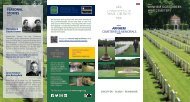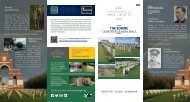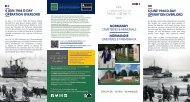CWGC - Runnymede leaflet 2023
Runnymede leaflet
Runnymede leaflet
- No tags were found...
Create successful ePaper yourself
Turn your PDF publications into a flip-book with our unique Google optimized e-Paper software.
IN<br />
REMEMBRANCE<br />
Download our App<br />
and find <strong>CWGC</strong> sites of<br />
remembrance near you.<br />
©Battle of Britain Monument<br />
Wing Commander<br />
Alois Vašátko<br />
Alois Vašátko, nicknamed ‘The Great Amos’, was<br />
a Czechoslovakian officer. Born in 1908, after<br />
the invasion of his home country, he fought with<br />
the French Air Force and became a fighter ace.<br />
Following the fall of France in 1940, he joined the<br />
Royal Air Force and was promoted to lead the<br />
Czechoslovak fighter Wing. Alois was killed in<br />
action during a dog-fight over the English Channel<br />
in 1942.<br />
We honour and care for the men and women of<br />
the Commonwealth forces who died in the First<br />
and Second World Wars, ensuring they will never<br />
be forgotten. Funded by six Member Governments,<br />
our work began with building, and now maintaining,<br />
cemeteries and memorials at over 23,000 locations<br />
all over the world.<br />
Access our records and archives online<br />
https://www.cwgc.org/find-records/<br />
Find out more about<br />
our charity.<br />
Visit:<br />
foundation.cwgc.org<br />
THE AIR FORCES<br />
MEMORIAL RUNNYMEDE<br />
Section Officer<br />
Noor Inayat-Khan<br />
©IWM HU 74868<br />
Noor Inayat-Khan was born in Moscow in 1914 to a<br />
Muslim family at the forefront of the movement to<br />
bring Sufism to the West. She grew up in London,<br />
then Paris. When the German army invaded<br />
France in May 1940, Noor escaped to Britain. In<br />
1940 Noor enlisted in the Women’s Auxiliary Air<br />
Force and trained as a wireless operator. In 1943<br />
she was recruited into the Special Operations<br />
Executive (SOE) and became the first female<br />
wireless operator sent into occupied France. Noor<br />
was arrested by the Gestapo in 1943. After making<br />
two attempts to escape, she was kept in solitary<br />
confinement for ten months in a German prison,<br />
before being sent to Dachau concentration camp<br />
where she was killed at the age of 30.<br />
Commemorated on Panel 64.<br />
See our specialist<br />
teams at work by<br />
visiting the <strong>CWGC</strong><br />
Visitors Centre near<br />
Arras, France<br />
Commemorated on Panel 243.<br />
Speak to our<br />
knowledgeable<br />
guides at the Ieper<br />
Information Centre,<br />
Ieper, Belgium<br />
To find out more visit www.cwgc.org<br />
DISCOVER LEARN REMEMBER<br />
Hurricane fighter being rearmed by RAF ground<br />
crew at North Weald, February 1941 ©IWM CH2530<br />
RAF Lancaster Bombers in formation<br />
over Germany, 1945 ©IWM TR 1156
THE WAR IN THE AIR<br />
The Air Forces Memorial, <strong>Runnymede</strong>, is one<br />
of the largest and most celebrated memorials<br />
built to commemorate those who died in the<br />
Second World War.<br />
The RAF saw some of the earliest action in the<br />
Second World War, and more than 116,000<br />
men and women of the Commonwealth Air<br />
Forces died during the war. The day after war<br />
was declared raids took place in which seven<br />
aircraft were lost and 25 airmen were killed,<br />
the first casualties in what would become a<br />
worldwide struggle to gain mastery in the air<br />
upon which victory depended.<br />
1<br />
4<br />
5<br />
THE MEMORIAL<br />
The Air Forces Memorial, <strong>Runnymede</strong>,<br />
commemorates more than 20,000<br />
Commonwealth airmen and women. They were<br />
lost in the Second World War during operations<br />
from bases in the United Kingdom and Northern<br />
and Western Europe and have no known grave.<br />
The memorial was unveiled on 17 October 1953<br />
by Queen Elizabeth II. 24,000 people attended<br />
the ceremony. The names of the missing are<br />
arranged by year of death on stone panels<br />
around a cloistered courtyard. The Stone<br />
of Remembrance stands at the heart of the<br />
memorial.<br />
The tower, reminiscent of a war-time RAF<br />
control tower, offers views across the nearby<br />
landscape including the <strong>Runnymede</strong> meadow<br />
where Magna Carta was sealed in 1215, the river<br />
Thames, Windsor Castle and Heathrow Airport.<br />
1<br />
Astral Crown: the heraldic symbol of the air forces<br />
2<br />
Stone panels: list the names of the missing<br />
3<br />
Commonwealth Coats of Arms: painted on the<br />
2<br />
6<br />
4<br />
cloister ceilings<br />
Great North Window: inscribed with the words from<br />
the Airman’s Psalm<br />
5<br />
Entrance Doors: feature zinc lions and the RAF motto<br />
‘Per Ardua Ad Astra’ (‘Through Adversity to the Stars’)<br />
6<br />
Tower: adorned with three stone figures<br />
representing Justice, Victory and Courage<br />
7<br />
Scallop Shells: a symbol of pilgrimage<br />
The Memorial is open every day except<br />
Christmas Day and New Year’s Day.<br />
Queen Elizabeth II unveils the Air Forces<br />
Memorial, <strong>Runnymede</strong>, in October 1953.<br />
3<br />
7<br />
For seasonal opening times, please visit:<br />
www.cwgc.org

















